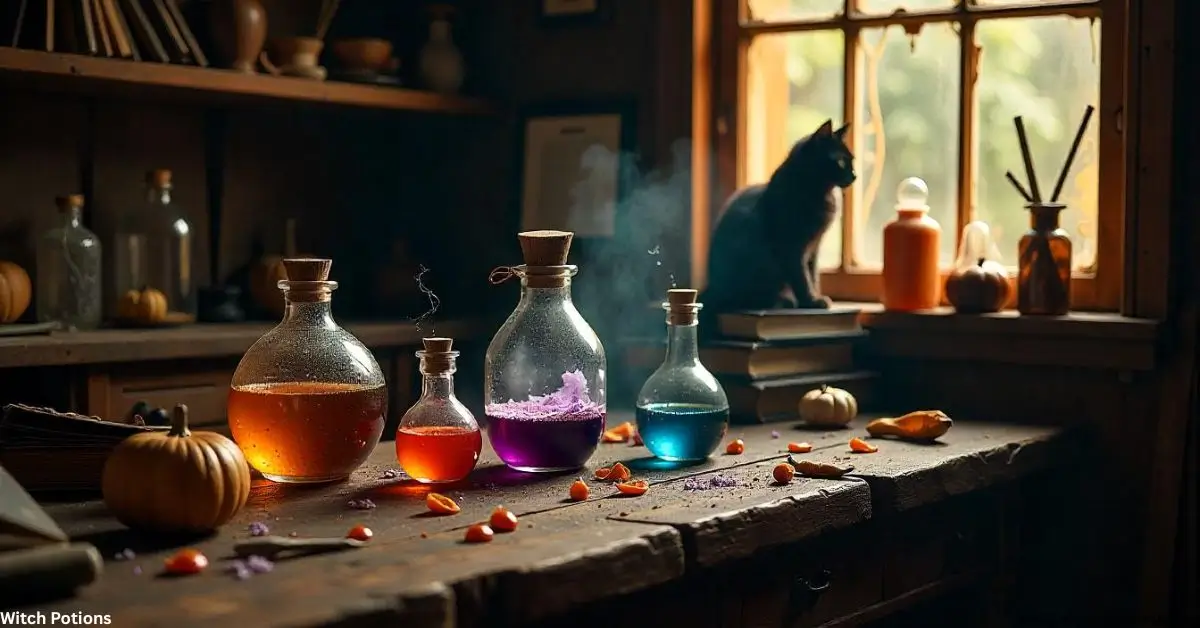Witch potions have captured human imagination for centuries. From ancient grimoires to modern fantasy fiction, these magical concoctions evoke a sense of mystery, power, and ancient knowledge. Crafted with herbs, crystals, and sometimes arcane ingredients, witch potions are far more than mere fantasy—they hold historical, spiritual, and cultural significance that spans civilizations. Whether used for healing, protection, or enchantment, the concept of witch potions continues to thrive in modern spiritual practices.
The Origins of Witch Potions
The origins of witch potions date back to ancient civilizations, where natural healers—often women—crafted herbal mixtures for ailments, divination, or spiritual communication. In Mesopotamia, Greece, Egypt, and Celtic regions, potion-making was tied closely to religion and medicine. These early brews were often based on botanical knowledge and were precursors to both pharmacy and modern witchcraft.
By the Middle Ages, potion brewing became associated with witchcraft. Fear and superstition led to a conflation of healers with witches, and their concoctions with dark magic. Despite persecution, the practice of potion-making never truly disappeared. It evolved, adapted, and resurged during the New Age movement, becoming integral to neo-pagan and Wiccan traditions.
Key Ingredients Found in Traditional Potions
No two witch potion are the same, but many include similar natural ingredients known for their metaphysical properties:
Herbs and Plants
Plants like mugwort, belladonna, mandrake, and sage have been widely used in spellwork and potion-making. Each herb carries specific energy: lavender calms, rosemary protects, and yarrow enhances psychic abilities.
Crystals and Minerals
Adding crushed crystals or soaking potions with crystal energy is a common modern practice. Amethyst, quartz, and obsidian enhance protection, clarity, and spiritual communication.
Essential Oils
Fragrant oils like frankincense, myrrh, and sandalwood are often mixed into potions to invoke specific intentions or spirits.
Water Sources
Moon water, river water, or blessed spring water serve as magical bases, infused with natural or celestial energy.
Types of Witch Potions and Their Purposes
Witch potions vary depending on the desired magical outcome. Some are consumed, others applied to the body, sprinkled around a space, or added to baths.
Healing Potions
These potions often use chamomile, peppermint, and calendula. They aid in physical and emotional healing and may also include crystals like rose quartz.
Love and Attraction Potions
Used to enhance self-love or attract others, these potions commonly feature rose petals, vanilla, and cinnamon. Some may even use honey or apple cider as sweet bases.
Protection Potions
To ward off negativity or spiritual harm, witches craft brews with black salt, cloves, and iron shavings, often sealed in vials or jars.
Wealth and Prosperity Potions
Cinnamon, ginger, bay leaves, and green aventurine are popular in money-drawing mixtures. They’re often sprinkled on wallets or kept in purses.
Dream and Sleep Potions
These typically combine valerian root, jasmine, and mugwort to promote vivid dreams, lucid dreaming, or restful sleep.
Crafting a Witch Potion: Step-by-Step Guide
Making witch potion involves intention, focus, and respect for ingredients. Here’s a simplified step-by-step guide:
Step 1: Set Your Intention
Begin by clearly identifying your goal. Whether it’s love, healing, or clarity, focus your mind and gather matching ingredients.
Step 2: Gather Ingredients
Use a blend of herbs, oils, water, and optional crystals. Cleanse everything physically and energetically, using sage or incense.
Step 3: Brew the Potion
Combine ingredients in a pot or cauldron. Simmer or steep them while focusing on your intention. Chanting or visualizing outcomes can amplify energy.
Step 4: Strain and Store
Once cooled, strain the potion into a glass bottle. Label it with the date and purpose. Store in a cool, dark place.
Step 5: Use the Potion
Drink it if it’s safe (using edible herbs only), apply it on skin, anoint tools, or sprinkle around a room. Always follow safety guidelines.
The Symbolism Behind Potions in Witchcraft
Witch potion are symbolic expressions of transformation. Mixing diverse elements mirrors the process of spiritual alchemy—changing energy and reality through will and intention. Every stir, scent, and sip becomes a ritual in itself. The physical act of crafting connects the witch to ancient practices, the natural world, and their inner power.
Modern Use of Witch Potions in Spiritual Practices
Today, witch potion are not just found in old spellbooks. They’re part of holistic wellness, aromatherapy, and spiritual healing. Many modern witches blend scientific knowledge with metaphysical principles. For example, using lavender for both its calming properties and its magical correspondence with peace and love.
Witchcraft communities online often share potion recipes and ingredients, promoting safe, ethical practices. Sustainability and conscious harvesting have become important values in potion-making today.
Ethical Considerations and Safety Tips
Crafting witch potions requires responsibility. Not all herbs are safe for ingestion, and some ingredients can interact with medications. Here are essential safety tips:
- Know Your Herbs: Research each ingredient for side effects or contraindications.
- Label Clearly: Always mark the contents, purpose, and warnings.
- Store Safely: Keep out of reach of children and pets.
- Avoid Animal Ingredients: Ethical witchcraft promotes cruelty-free practices.
- Do Not Use Toxic Items: Avoid mercury, lead, and dangerous fungi.
Comparison Chart: Common Witch Potions and Their Uses
| Potion Type | Key Ingredients | Primary Purpose | Application Method |
| Healing | Chamomile, calendula, rose quartz | Emotional and physical aid | Tea, bath, anointing |
| Love & Attraction | Rose, vanilla, honey, pink candle wax | Romance or self-love | Perfume, spell jar, tea |
| Protection | Black salt, garlic, obsidian | Shield from negativity | Room spray, vial, bath |
| Wealth & Prosperity | Bay leaf, cinnamon, green aventurine | Financial luck | Wallet charm, spray |
| Dream & Sleep | Mugwort, valerian root, amethyst | Vivid/lucid dreaming | Pillow mist, tea, oil rub |
How to Customize Your Own Witch Potion
Creating a personal witch potion allows you to tune into your intuition and needs. Begin by journaling your goal, then choose ingredients that resonate with that energy. Trust your instincts—witchcraft is as much art as it is tradition.
You can also align potions with lunar phases:
- New Moon: New beginnings
- Full Moon: Power, manifestation
- Waning Moon: Releasing negativity
Color magic can enhance your work—use containers, herbs, or candles that match the energy you’re calling in (e.g., green for abundance, red for passion).
Storing and Recharging Potions
To keep witch potions potent, store them in glass bottles away from sunlight. Amber bottles are ideal. Recharging under moonlight, burying near sacred trees, or placing beside crystals like selenite can refresh the energy.
If a potion feels “off” or stale, it’s time to thank it and dispose of it respectfully—pour it into the earth or running water.
Conclusion
Witch potions remain one of the most enchanting and empowering aspects of spiritual practice. Whether you’re a seasoned practitioner or a curious beginner, crafting your own potions connects you to ancient wisdom, natural cycles, and personal intention. These mystical mixtures invite mindfulness, creativity, and deeper connection with the unseen forces around and within us. By learning to craft safe, ethical, and effective potions, modern witches keep the old ways alive infusing their lives with intention, healing, and transformation.
FAQ’s:
1. Are witch potions safe to drink?
Yes, but only if they’re made from food-safe herbs. Always research ingredients and consult experts when in doubt.
2. Can anyone make a witch potion?
Absolutely. Anyone with respect for the craft, intention, and knowledge of ingredients can make potions.
3. What’s the difference between a spell and a potion?
A spell is a ritual act using words and gestures, while a potion is a physical liquid used to aid or amplify magical intent.
4. Do potions really work?
Their effectiveness depends on belief, intention, and alignment with natural energies. They are spiritual tools, not guaranteed outcomes.
5. Where can I find potion ingredients?
Most ingredients can be found in health stores, herbal shops, or your kitchen. Always choose ethical and natural sources.
6. How long do witch potions last?
Depending on ingredients and storage, potions can last a few weeks to several months. Always check for spoilage before use.












